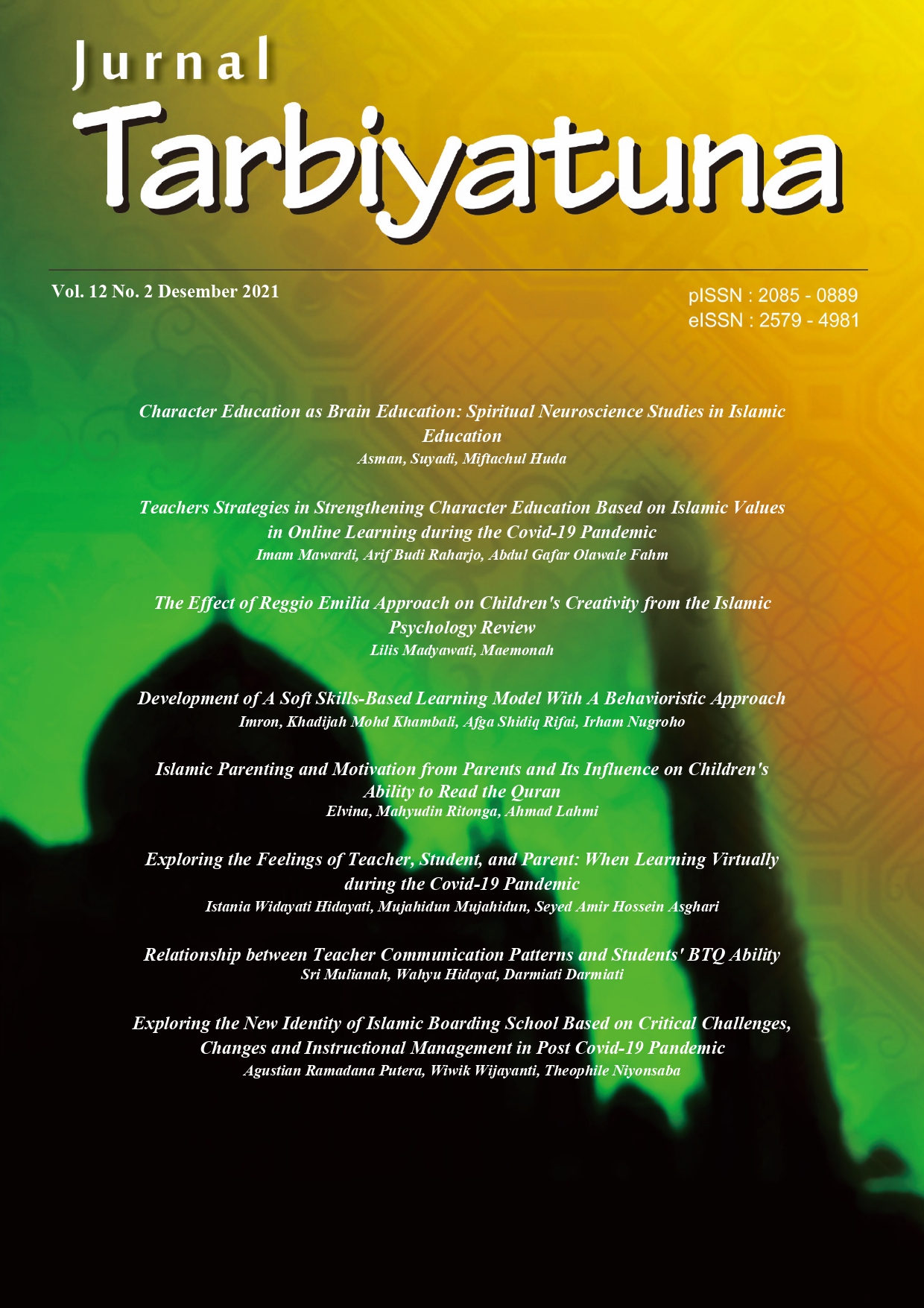Main Article Content
Abstract
Learning in the classroom is an important aspect of transmitting soft skills to students and a behavioristic approach has promising potential to be integrated with the process. The purpose of this research was to: (1) to determine the implementation of soft skills-based learning model development; and (2) to discover the development of a soft skills-based learning model to improve soft skills in students of the Faculty of Islamic Religion, University of Muhammadiyah Magelang. Therefore, this was a classroom action research and the design used was the model developed by Kemmis and Taggart. This consisted of four components, namely, planning, action, monitoring, and reflection. Furthermore, this research used the descriptive-quantitative analysis technique and three data collection methods namely observations, interviews, and questionnaires. These results indicated that: (1) the development of a soft skills-based learning model with a behavioristic approach is performed in several stages, namely: (a) the planning stage which includes soft skills attributes, lesson plans, and learning models determination including making assessment instruments; (b) implementation stages; (2) Development of soft skill-based learning model using a highly effective behavioristic approach to improve students' soft skills. This can be observed in the acquisition of soft skills scores, which were on average 10.6 at the start of the lecture and 20.41 at the conclusion.
Keywords
Article Details

This work is licensed under a Creative Commons Attribution-NonCommercial 4.0 International License.
References
- Afifah Hanim Md Pazil, R. C. (2019). Perspectives of Asian Employers on Graduates' Softskills: A Systematic Review. Universal Journal of Educational Research, 7(11), 2397-2405.
- Atmaja, P. (2011). Psikologi Pendidikan dalam Perpektif Baru. Ar-Ruzz Media.
- Elvy Pang, M. W. (2018). Competencies for fresh graduates’ success at work: Perspectives of employers. Industry and Higher Education, 33(1), 55-65.
- Hamidah, S., F. Rahmawati, dan A. J. (2013). Pembelajaran Softskill Terintegrasi bagi Pertumbuhan Karakteristik Pekerja Profesional Bidang Boga. Jurnal Pendidikan, 43 Nomor 2, 164–173.
- Hamidah & Sri Palupi. (2012). Peningkatan Softskills Tanggung Jawab Dan Disiplin Terintegrasi Melalui Pembelajaran Praktik Patiseri. Jurnal Pendidikan Karakter, 2, 143–152. https://doi.org/10.21831/jpk.v0i2.1299
- Hamidah, S. (2012). Model Pembelajaran Softskills Terintegrasi Soft-Skills Integrated Learning Model for Vocational High School Students of Home Economics Education. Jurnal Pendidikan Vokasi, 2 No. 1, 53–62.
- Hasanah et al., H. et al. . (2020). Softskills Integrated Learning Model in Electronic Practice Courses in Higher Education. International Journal of Mechanical and Production Engineering Research and Development, 10(3), 13849–13860. https://doi.org/10.24
- Herwina, W., Madjid, H. A., & Daniel, H. (2018). Pengembangan Model Pembelajaran Terintegrasi Softskill dan Hard Skill dalam Meningkatkan Kompetensi Warga Belajar pada Lembaga Kursus Kecantikan. Jurnal Ilmiah VISI PGTK PAUD Dan DIKMAS, 13(1), 37–47.
- I Wayan Arnata, S. S. (2014). Evaluasi Softskills dalam Pembelajaran Mahasiswa Baru di Fakultas Teknologi Pertanian Universitas Udayana. Jurnal Pendidikan dan Pembelajaran, 21(1), 2.
- Jefri Mailol, S. A. (2020, April). Lecturers’ Experiences In Teaching Softskills In Teacher Profession Education Program (Tpep) In Indonesia. Problems Of Education In The 21st Century, 78(2), 216-232.
- LuisFernández-Sanz, M. J. (2017). A study on the key softskills for successful participation of students in multinational engineering education. nternational Journal of Engineering Education, 33(6B), 2061-2070.
- Maqual Stephen Maren, U. K. (2021). Integrating Softskills into a Teacher Education Curriculum. International Journal of Psychosocial Rehabilitation, 25(2), 1475-7192.
- Marzuki. (2012). Pengembangan Softskills Berbasis Karakter Melalui Pembelajaran IPS Sekolah Dasar. Staff.Uny.Ac.Id.
- Muqowim. (2012). Pengembangan Softskills Dosen. PT. Pustaka Insan Madani.
- Ngang, T. K., Yunus, H. M., & Hashim, N. H. (2015). Softskills Integration in Teaching Professional Training: Novice Teachers’ Perspectives. Procedia - Social and Behavioral Sciences, 186, 835–840. https://doi.org/10.1016/j.sbspro.2015.04.204
- Nurul Huda SA, S. A. (2021, Januari). Experiences of Participants in Teacher Professional Education on Obtaining Softskills: A Case Study in Indonesia. European Journal of Educational Research, 10(1), 313-325.
- Patrícia Raquel da Silva Fernandes, J. J. (2021, Maret). The Softskills of Special Education Teachers: Evidence from the Literature. Education Sciences, 11(125), 1-13.
- Parjono dkk. (2007). Panduan Penelitian Tindakan Kelas, Seri Metodologi Penelitian. Lembaga Penelitian Universitas Negeri Yogyakarta.
- Siti Hamidah. (2013). Pembelajaran Softskills Terintegrasi Bagi Penumbuhan Karakter Pekerja Profesional Bidang Boga. 43(2).
- Sri Palupi. (2011). Upaya Membangun Karakter (Softskills) Mahasiswa Bidang Boga. Prosiding Pendidikan Teknik Boga Busana, 6(1).
- Tabah Subekti. (2016). Efektifitas Penggunaan Modul Perkuliahan Pendidikan Bhasa Dan Sastra Indonesia Berbasis karakter Terhadap pemahaman Kurikulum 2013pada Mahasiswa Prodi PGSD Universitas Muhammadiyah Magelang. Tarbiyatuna, 7(1), 14–24.
- Undang Undang Sistem Pendidikan Nasional Tahun 2003. (n.d.).
- Wiriaatmadja, R. (2012). Metode Penelitian Tindakan Kelas Untuk Meningkatkan Kinerja Guru Dan Dosen. Bandung: PT Remaja Rosdakarya. PT Remaja Rosdakarya.
